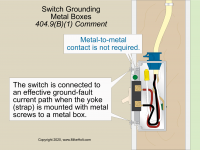- Location
- Chapel Hill, NC
- Occupation
- Retired Electrical Contractor
I saw this article by Mike Holt on ec&m. If this is true it is new to me. There is no equipment grounding conductor connected. Not sure anyone can view the article but here is the link https://www.ecmweb.com/content/arti...es-between-grounding-and-bonding-part-9-of-12
What do you think? I always thought you needed self grounding device unless it had metal to metal contact. According to the article you only need that for receptacles.

Fig. 1. Direct metal‑to‑metal contact between the device yoke of a switch and the box is not required.
Snap switches, dimmers, control switches, and metal faceplates are considered connected to an EGC using either of the following methods:
(1) Metal boxes. The switch is mounted with metal screws to a metal box or a metal cover that is connected to an EGC per Sec. 250.148.
Direct metal-to-metal contact between the device yoke of a switch and the box is not required. The switch is connected to the effective ground-fault current path when the yoke is mounted with metal screws to a metal box (Fig. 1).
(2) Nonmetallic boxes. The grounding terminal of the switch yoke must connect to the circuit EGC.
Exception No. 1: Where no means exist within the box for bonding to an EGC, or if the wiring method at the existing switch does not contain an EGC, a switch without such a connection to the EGC is permitted for replacement purposes only. A switch installed under this exception must have a nonmetallic faceplate with nonmetallic screws, or the replacement switch must be GFCI-protected.
Exception No. 2: Listed assemblies are not required to be bonded to an EGC if all four conditions in this exception are met. For example, the device has a nonmetallic yoke.
Exception No. 3: An EGC is not required for bonding a snap switch with an integral nonmetallic enclosure complying with Sec. 300.15(E).
Metal enclosures for switches and circuit breakers must be connected to an EGC of a type recognized in Sec. 250.118 [Sec. 250.4(A)(3)]. Where nonmetallic enclosures are used with metal raceways or metal-armored cables, they must comply with Sec. 314.3 Exception No. 1 or Exception No. 2 [Sec. 404.12].
What do you think? I always thought you needed self grounding device unless it had metal to metal contact. According to the article you only need that for receptacles.

Fig. 1. Direct metal‑to‑metal contact between the device yoke of a switch and the box is not required.
Article 404 ― Switches
The metal mounting yokes for switches, dimmers, and control switches must connect to an equipment grounding conductor. Metal faceplates must be bonded to the equipment grounding conductor (EGC) [Sec. 404.9(B)].Snap switches, dimmers, control switches, and metal faceplates are considered connected to an EGC using either of the following methods:
(1) Metal boxes. The switch is mounted with metal screws to a metal box or a metal cover that is connected to an EGC per Sec. 250.148.
Direct metal-to-metal contact between the device yoke of a switch and the box is not required. The switch is connected to the effective ground-fault current path when the yoke is mounted with metal screws to a metal box (Fig. 1).
(2) Nonmetallic boxes. The grounding terminal of the switch yoke must connect to the circuit EGC.
Exception No. 1: Where no means exist within the box for bonding to an EGC, or if the wiring method at the existing switch does not contain an EGC, a switch without such a connection to the EGC is permitted for replacement purposes only. A switch installed under this exception must have a nonmetallic faceplate with nonmetallic screws, or the replacement switch must be GFCI-protected.
Exception No. 2: Listed assemblies are not required to be bonded to an EGC if all four conditions in this exception are met. For example, the device has a nonmetallic yoke.
Exception No. 3: An EGC is not required for bonding a snap switch with an integral nonmetallic enclosure complying with Sec. 300.15(E).
Metal enclosures for switches and circuit breakers must be connected to an EGC of a type recognized in Sec. 250.118 [Sec. 250.4(A)(3)]. Where nonmetallic enclosures are used with metal raceways or metal-armored cables, they must comply with Sec. 314.3 Exception No. 1 or Exception No. 2 [Sec. 404.12].


